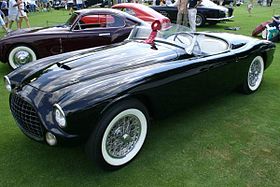Ferrari 212 Inter
| Ferrari 212 Inter | |
|---|---|
 |
|
| Overview | |
| Manufacturer | Ferrari |
| Production | 1951–1952 82 produced |
| Designer | Carrozzeria Touring,Pininfarina, Vignale, Ghia, Stabilimenti Farina |
| Body and chassis | |
| Class | Sports car |
| Layout | FR layout |
| Powertrain | |
| Engine | 2.6 L Colombo V12 |
| Chronology | |
| Predecessor | Ferrari 195 Inter |
| Successor | Ferrari 250 |
The Ferrari 212 Inter replaced Ferrari's successful 166 and 195 Inter grand tourers in 1951. Unveiled at the Brussels Motor Show that year, the 212 was an evolution of the 166 — a sports car for the road that could also win international races.
The chassis was similar to the 125 with a suspension featuring double wishbones in front and live axle in back. Coachbuilders included Carrozzeria Touring, Ghia, Ghia-Aigle, Vignale, Stabilimenti Farina, and now Pinin Farina. The latter was an important move for the company, as Farina was already well-known and adding his styling skills would be a tremendous boost for Maranello. However, Pinin Farina was as prideful as Enzo Ferrari, and neither would go to the other to request business up to this point. A mutual meeting halfway between Maranello and Turin was the negotiated solution. First Ferrari to be bodied by Pinin Farina was 212 Inter Cabriolet, chassis no. 0177E.
The Inter's 2,600 mm (102.4 in) wheelbase was 4" longer than the 2,500 mm (98.4 in) Export's. The cars shared a larger, bored-out (68 mm) 2.6 L (2563 cc/156 in³) version of Ferrari's Colombo V12 engine. Output was 150 hp (111 kW) for the single Weber 36DCF carburetor Inter, 165 hp (123 kW) for the triple Weber Export. Improved cylinder heads raised power 5 hp (3.7 kW) in 1952.
The British magazine got hold of what they described as the first production model Ferrari 212 in 1950, which outperformed any car that they had previously tested. It recorded a top speed of over 116 mph (187 km/h) and acceleration times of 0 to 60 mph (96 km/h) of 10.5 seconds and 100 mph (161 km/h) in 22.5 seconds; the magazine however noted they had limited the engine to 6,500 rpm out of respect for the newness and low mileage of the car they were using, which suggested that even better performance would be available from a fully "run in" model. The test appears also to have been the Autocar team's first encounter with a five speed gear box.
...
Wikipedia
